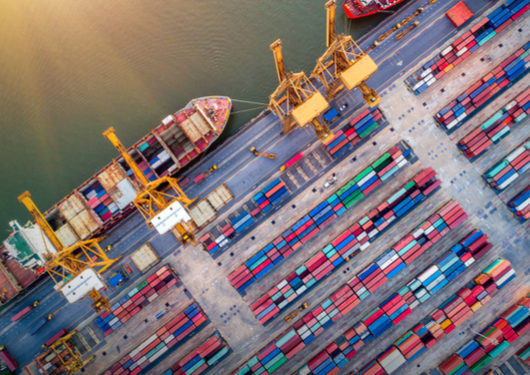.jpg?height=100&t=1742184082&width=150)
Visit Our Sponsors |
|
|
|
|
|
|
|
|
|
|
|
|
|
|
|
|
|
|
|
|
|
|
|
|
|
|
|
|
|
|
|
|
|
|
|
|
|
|
|
|
|
|
|
|
|
|
|
|
|
|
|
|
|
|
|
|
|
|
|
|
|
|
|
|
|
|

But, in the absence of that, a more pragmatic approach that involves plugging information gaps and investing in judiciously deployed tracking devices can get you closer than you might imagine.
The dream of accurate, instantly available, detailed visibility of goods as they pass along the international supply chain is one logistics industry executives and the shippers they serve continue to seek with a range of emotions, from winsome desire to white-knuckled frustration. But it remains elusive.
To be sure, there has been significant progress. Software systems that serve specific functions of the supply chain do an impressive job of keeping track of things — warehouse management systems (WMS) are good enough to allow efficient robotic pick and packing operations. Transportation management systems allow for unprecedented control in costs, as does labor management software. Many have good reason to be proud of gains in operational efficiency in parts of their supply chain, reaching as high as 90 percent. But those tend to be rare, bright windows. Inventory in transit is still mostly in the murk.
“How far have we come?” asks Carlos Alvarenga, executive director at World 50, adjunct professor at University of Maryland and former global managing director of Accenture’s Supply Chain Services practice. “A lot less than people expected or hoped. Of course, it’s better than it was, but there’s still more unseen and undone in this space than seen and done. You still see that people think that things are moving when they’re not, or are not moving when they are,” Alvarenga lamented. “Most of the supply chain is not visible, most of the relationships that exist are not fully understood, and most companies don’t have a good sense of what’s moving when and where.”
Amazon and its followers are spending a fortune getting better control of inventory traveling the last mile to the consumer. But, when it comes to getting hold of the information they need the most about goods further back up the supply chain, everyone suffers the same problems. You initiate the long journey an item must take and pray it gets to where it needs to be, on time and in good shape. Whether en route from a factory in Vietnam, on its way through a West Coast port, or in the back of a truck somewhere in Indiana, tracking inventory is generally an exercise in best-guessing.
There’s nothing inherently wrong with estimates and predictions. Most of us would rather have a weather forecast than nothing at all. It’s just that estimates and predictions about the movement of goods are better in some parts of the supply chain than others. For example, where a WMS might offer accuracy well above 90 percent when estimating what SKUs are available in a warehouse, our experience is that ETA accuracy on cargo shipments arriving at ports or DCs can average as low as 30 percent. And, of course, low levels of accuracy at any point in the supply chain have a knock-on effect down the line. Inaccurate ETAs drive increased safety stock, delays down the line, demurrage fees, and on and on. A car with a turbo-charged engine can’t run well on a flat tire.
Any supply chain is only as efficient as its least well-functioning part. Problems include:
In-transit disruptions
Lack of after-the-fact visibility to make future corrections
High-value shipments misplaced, stolen or spoiled
Regulated goods missing or delayed
Difficulty scheduling staff due to unknown location of critical items in transit
To really orchestrate an efficient supply chain you’d ideally have live-streaming visibility, producing real-time data about what happens in transit. That, in turn, enhances the efficiency of all other systems because it feeds them with valuable input. But how do you get there without breaking the bank, becoming mired in IT complexity or getting drowned in data?
A pragmatic approach combines real-time sensor technology with big data methodologies that improve the predictability of transportation operations.
Waiting for all service providers in the supply chain to start sharing information freely and promptly is a waste of time.
We can stop standing behind a podium at industry conferences saying it’s going to happen, because it’s not. A far more sensible approach is to craft a solution on behalf of the shipper or receiver of product, who truly needs to be controlling and gathering this information, by addressing blind spots.
The primary dark patches in global supply chains tend to occur at transhipment points, when goods are transferred from carrier to carrier, or rail to ocean, or ocean to truck, or truck to another truck. Those handoffs are the blind spots. A shipper will get a milestone notice that a container arrived at a port, but the latency inherent in the system typically means they won’t get that for a day or two. The same goes for the notice that a carrier has picked up that container; sometimes that takes a day or two, as well. In truth, sometimes those messages just don’t show up at all.
Smart, affordable sensor technology can really help fill those information gaps, allowing you to know exactly where a container is at all times, and who’s responsible for it at any point in time, too.
In the past, this type of tracking relied on RFID technology, which required readers fixed in strategic locations. But new internet of things (IoT) GPS/mobile sensor technology travels with the asset and delivers information like a cell phone, making it potentially ubiquitous.
Removable sensors that use GPS and mobile technology have been around for quite a while, but have only hit the price point where they become affordable for practical deployment in the last two years or so. Cost-effective sensors can now cost $50 or less, and can transmit every hour for 60 days without changing or charging a battery (you then change or charge the battery and use the sensor again). These are perfect for tracking high-value assets or goods such as pharmaceuticals, electronics, oil or gas. More sophisticated IoT sensors can be applied to scenarios where there’s a need to monitor cargoes with higher security requirements, offering an electronic seal that is superior to the conventional plastic seal, which can easily be removed and replaced with a counterfeit. These are more expensive, but worth it for cargoes such as bio-pharmaceuticals, high-end electronics and high fashion items, where a single shipment can be worth millions of dollars. They are also a great tool for monitoring high-consequence shipments such as controlled chemicals, where you want to ensure the cargo has not been tampered with and, if it has been, the exact location.
Movable sensors are great because you don’t have to worry about setting up the infrastructure for RFID readers. A container on the ocean can access a cell phone signal, but elsewhere, you can work with a satellite technology partner to keep track far from cell coverage.
Track and trace technology in the past has tended to rely on EDI messages being generated by service providers, but these are often triggered by human activity, and sometimes the data entry is human-based too. You need someone to type in the right information and hit a button. An advantage of removable readers using an IoT GPS/mobile sensor is that this new IoT sensor technology is all automated, making the information objective. You don’t want to depend on a driver who might be penalized for late arrival to tell you whether they arrived on time.
But the downside is you then run the risk of having too much data. This is where big data technology comes in, because you really need good technology to consume and sort that much data, to make it actionable. The great advantage there is that, paired with artificial intelligence (AI), we don’t just know what has happened; we can make very accurate predictions about what is going to happen.
In fact, you don’t necessarily have to use GPS/mobile sensors. Using big data, it is possible to build models that predict arrival times and dwell times at ports, for example, based on a vast trove of historical information.
Once you tie this in with other, EDI-based milestone information you actually do get from rail, truck and ocean carriers, and layer in data about other elements, such as strikes, high-crime areas, and traffic patterns, you can start to string together enough information to create really good predictions. Sprinkle in a little smart math and you can forget about everybody sharing their data, or humans being accurate and unbiased in data entry, because you have enough to predict what’s going to happen.
One real-world problem this helps address is where vessels fail to deliver containers to the scheduled port, due to disruption or congestion. Sometimes, faced with problems at a port, a carrier will just cut and run, go to a nearby port, drop off the containers that should have gone to the port they skipped, and arrange for truck or rail to take them back. It’s not uncommon for a shipper to have no idea this has happened until days later. This, in turn, plays havoc with ETAs inland. With big data and AI, you gain predictive abilities to make a better estimate of when cargo will arrive, and where.
The implications of adopting smarter, more pragmatic ways of getting supply chain visibility are far-reaching. “Even the best supply chain companies still struggle to know the sources of things and where they’re coming from,” said Alvarenga. “We constantly hear from senior executives who say: ‘I don’t know where my suppliers get their materials from.’ There’s a need for end-to-end flow of information.” Alvarenga points to a variety of technologies and methodologies shippers employ to fill in those gaps and try to recreate what’s happened in the murk of the supply chain. Seeking end-to-end efficiency through maximum visibility of goods in transit is a big challenge, and will continue to be so. But focusing on blind spots is the way to go. “Is it better to fill in the gaps than wait for nirvana?” asks Alvarenga. “Yes, I think so.”
Resources: Savi
RELATED CONTENT
RELATED VIDEOS
Timely, incisive articles delivered directly to your inbox.
.jpg?height=100&t=1742184082&width=150)





